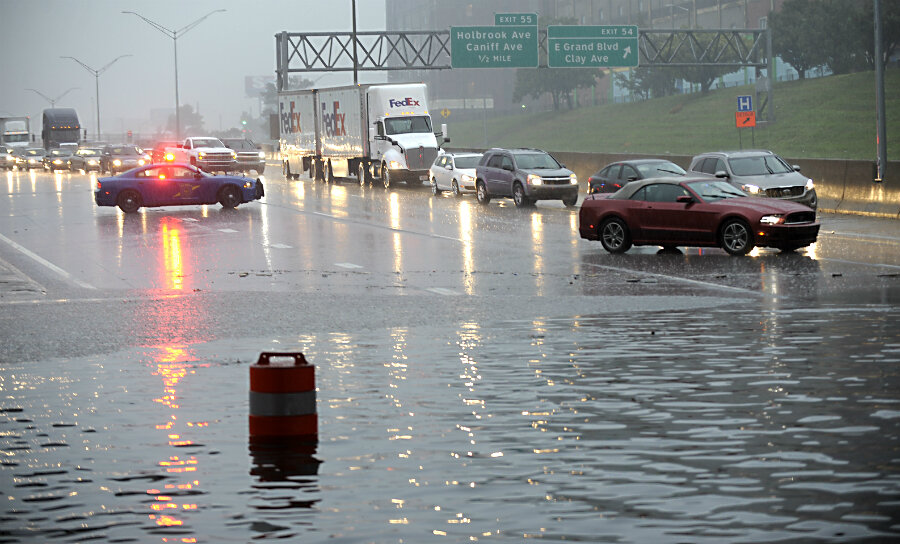Cities enlist nature to tame rising flood risks
Loading...
| Detroit
If Ronier Golightly forgets to tend to the street drain near his home, this Northwest Detroit neighborhood might be mistaken for an ephemeral Great Lake after a rain.
The infrastructure in this community just south of the Eight Mile Road, which divides the city from its northern suburbs, has long been problematic. Mr. Golightly and his two neighbors have the unofficial job of clearing leaves from gutters, which has a measurable effect on road flooding.
“Get a rake and make sure the drain is clear. We’ve been doing it so much that it’s just like guaranteed, it’s not a big deal anymore,” Golightly, a former radio DJ and current popcorn entrepreneur, said as he walked his neighborhood one day earlier this fall. “We knew it was going to get backed up. It doesn’t even take a deep rain.”
The city’s pipeline system, like many other older American cities, carries both sewage and street runoff. But rains are getting heavier here – an August 2014 flash flood cost Metro Detroiters an estimated $1.8 billion in property damage – a shift that climate scientists link to climate change. That means the city’s already aging pipes, tunnels, and pumps that carry fluids to wastewater treatment facilities are increasingly strained, leaving pools of water on streets after downpours.
“If it rains a good amount and, in a good amount of time, you automatically know to go in the basement, get everything off the floor,” said Golightly, a squat man dressed in a black “Bad Boys” era Detroit Pistons t-shirt covered by a half-zipped white hoodie. “It’s to the point where you can’t stop it.”
In the past, Detroit would have used steel to solve this problem. Like other cities with so-called combined sewage overflow systems, Environmental Protection Agency (EPA) regulations have forced Detroit to find ways to alleviate the stress on its system. After investing $1 billion in such projects in the 1990s and 2000s, the estimated bill for building more pipelines grew too steep.
So the city went a different route by embarking on a plan to use or restore natural landscapes like wetlands and floodplains to absorb stormwater and floods, a tactic known as “green infrastructure.”
'Bioswales' and pickleball courts
“You get to a point where there’s a law of diminishing returns,” said Palencia Mobley, deputy director and chief engineer the Detroit Water and Sewerage Department. “The department said we can’t continue with the long-term control plan, but can we use green infrastructure?”
Viola Liuzzo Park, across from Golightly’s home, is torn up. The city is fitting it with “bioswales” to filter rain through the soil into retention zones buried underground.
“This area right here will be called a pickleball court,” Golightly said, surveying the torn-up park, surrounded by chain-link fence, as construction crews installed the retention infrastructure.
Pickleball?
“Yeah, I didn’t know what that was. Initially it was a tennis court in the plans, but once the city of Detroit reviewed it they said it was too close to the street. … Apparently, it’s supposed to be like tennis.” Golightly said. He added that a picnic area and a garden are coming too, though he seems a little sour about pickleball, especially since the neighborhood association shot down his play for a basketball court. “I still don’t know what it is, exactly.”
Cost-effective climate response
What cities are learning is that green infrastructure could prove a low-cost approach to relieving inundated pipelines as climate change intensifies storms, all the while adding community amenities like greenspace. Heavy rainfalls are a fingerprint of climate change because a warmer atmosphere causes more evaporation and holds more moisture, while precipitation is released in more substantial storms.
“We are truly seeing rainfall events that are higher intensity and larger volumes,” said Carol Hufnagel, national wet weather practice leader with Tetra Tech, the firm giving Golightly’s neighborhood a green infrastructure makeover. She noted a July 9 storm in Golightly’s neighborhood was the most intense rainfall ever recorded there.
Flooding can even be a risk during snow season, if a warm front or spring melt-off combines with heavy rainfall.
For many cities, green infrastructure was merely a tactic for satisfying the EPA’s combined sewer overflow rules and for improving water quality by sending water through grass and soil to remove toxic metals and other contaminants.
But in recent years, the method has gained credence as a buffer against climate change, said Robert Traver, a professor and director of the Villanova Urban Stormwater Partnership at Villanova University in Philadelphia, a city replete with porous pavement and other projects that’s turned it into the US poster child for green infrastructure.
Mr. Traver said green infrastructure has been more effective at swallowing rainstorms than he originally thought possible. He was surprised at how ably it handled superstorm Sandy, which slammed East Coast cities in October 2012. A relatively small site on Villanova's campus in Philadelphia dispensed with all the excess runoff it incurred, with the water infiltrating through the soil over the course of three days. The site was wide and shallow, enabling filtration over a broader swathe of land in a shorter period of time than deep and narrow designs.
"You can spend a whole chunk of money on tunnels like some cities have, or you can spend less on green infrastructure and get the same results and the benefits,” Traver said, while noting that space is a limitation for many cities. “We’re just starting to really untap the potential of green infrastructure.”
The Obama administration has championed green infrastructure as well. It jumpstarted a number of federal workshops and planning tools to assist local officials and now requires federal agencies to consider green infrastructure and other “ecosystem services” in their planning. It’s also spending on research – the EPA partially funds some of the work Traver does at Villanova, for example.
How much is needed?
The challenge for city planners is figuring out just how much rain they might get with climate change, said Jon Hathaway, an assistant professor of civil and environmental engineering at the University of Tennessee at Knoxville. He’s working with Oak Ridge National Laboratory and the National Science Foundation to synthesize climate models to put lower and upper bands on precipitation projections and also to explore how to better site green infrastructure in space-constrained urban environments.
Of course, there are limits to what green infrastructure can achieve. Places like Houston and Baton Rouge, La., both of which have endured heavy flooding this year, will likely continue to face challenges simply because they were built in floodplains.
Green infrastructure, if properly placed, can significantly lessen the burden on vulnerable areas and chip away at overall system strain compared with traditional models that funnel everything to a single discharge point, Mr. Hathaway said.
“We call it buffering capacity. Essentially to what degree can we take intense rainfall and buffer it a little bit, shave off the intensity of these rainfall events,” Hathaway said.
Houston, for what it’s worth, this year appointed a “flood czar.” The city also is engaged in a $220 million public-private partnership to add 150 miles of green space by 2020 for stormwater detention at city parks. The Houston Parks Board, in coordination with the Harris County Flood Control District, is buying land to protect against development and add green infrastructure.
“[We] target areas that are in need of park space that at the same time could serve in the flood control arena,” said Beth White, president of the Houston Parks Board, adding. “When you have three floods in a row, it’s something that’s at the forefront of everyone’s mind.”
But Houston is emblematic of what green infrastructure advocates are now trying to reverse: As communities sprawled, developers turned former floodplains into houses, disrupting natural hydrology. Pavement and rooftops robbed rain’s pathways back into the earth. Swelling cities added more sewage to city infrastructure, further taxing both engineered and natural systems – the more modern urban environments that rely on streams and rivers to carry wastewater are seeing waterways overflow more often as runoff from intensifying storms grows.
“The amount of water they’re carrying and the frequency wreaks havoc on them,” Hathaway said. “In those scenarios green infrastructure is an opportunity to bring hydrology to something more natural. And when we do that, the hope is that those local streams are not going to get pounded as frequently as they are.”
Just a few weeks before his visit to the park, the side of the street where Golightly stood was flooded, as precipitation peppered the Motor City. That should occur less often with the park improvements.
“I didn’t know it was going to be this massive,” said Golightly. “This area here – I read up on it – back 200 years ago it was a swamp area,” he adds. “Even here, if it rains good, a day or two later if you walk through it your feet sink.”
That return to natural hydrology, or water flow, is already showing benefits in Detroit, Ms. Mobley said. The city accomplished its near-term goal of removing 2.8 million gallons of stormwater from its sewage system just by demolishing vacant homes, in turn allowing greenspace to absorb rain. Green infrastructure also cools the atmosphere by pulling out carbon dioxide, and removes heat energy by cycling water through a natural system rather than letting it evaporate on pavement.
Spin-off benefits for residents
“There was something here before man was here, and man thinks he was really smart and puts in all these buildings and roads. But that wasn’t here. So green infrastructure tries to mimic natural structures,” Mobley said. “It should help with the impact of climate change.”
Mobley is also interested in the side benefits green infrastructure could bring to residents. According to an ongoing University of Michigan study, residents near four Detroit neighborhoods where vacant lots were turned into stormwater retention areas with parks reported feeling safer, were more willing to walk, and felt their property values would increase.
Golightly shares that optimism for his neighborhood. He thinks the revitalized park will get people outdoors and talking to each other again, the way he remembers neighbors doing when he was a child.
And, in the meantime, it might relieve him and his neighbors of their makeshift drainage maintenance duties.
“Right now it’s all about teamwork,” Golightly said. “But it’s cool, though.”









